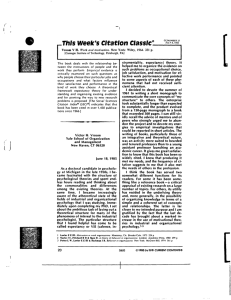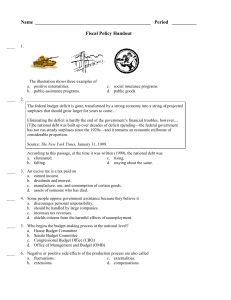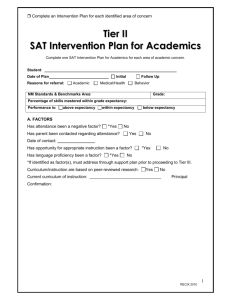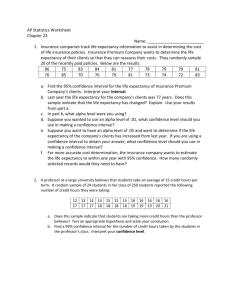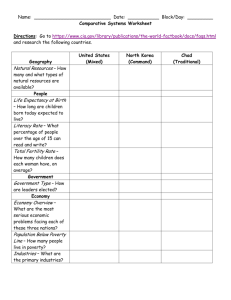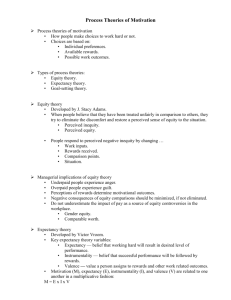Vroom's Expectancy Models and Work-Related
advertisement
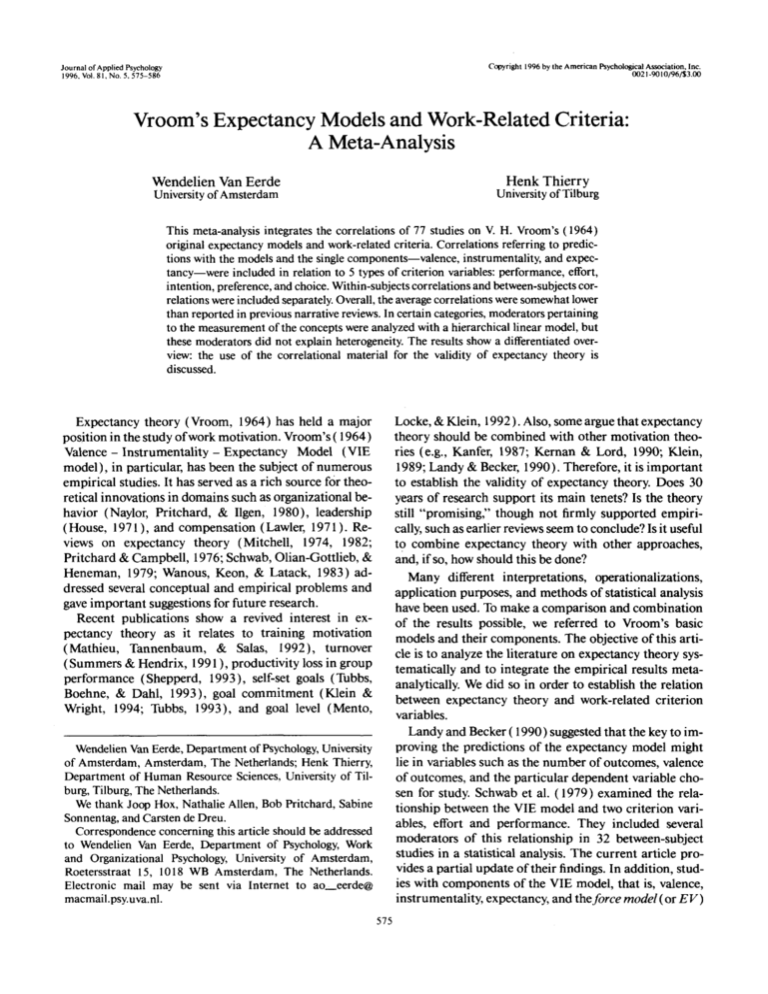
Copyright 1996 by the American Psychological Association, Inc. 0021-9010/96/53.00 Journal of Applied Psychology 1996, Vol. 81, No. 5, 575-586 Vroom's Expectancy Models and Work-Related Criteria: A Meta-Analysis Henk Thierry University of Tilburg Wendelien Van Eerde University of Amsterdam This meta-analysis integrates the correlations of 77 studies on V. H. Vroom's (1964) original expectancy models and work-related criteria. Correlations referring to predictions with the models and the single components—valence, instrumentality, and expectancy—were included in relation to 5 types of criterion variables: performance, effort, intention, preference, and choice. Within-subjects correlations and between-subjects correlations were included separately. Overall, the average correlations were somewhat lower than reported in previous narrative reviews. In certain categories, moderators pertaining to the measurement of the concepts were analyzed with a hierarchical linear model, but these moderators did not explain heterogeneity. The results show a differentiated overview: the use of the correlational material for the validity of expectancy theory is discussed. Expectancy theory (Vroom, 1964) has held a major position in the study of work motivation. Vroom's (1964) Valence - Instrumentality - Expectancy Model (VIE model), in particular, has been the subject of numerous empirical studies. It has served as a rich source for theoretical innovations in domains such as organizational behavior (Naylor, Pritchard, & Ilgen, 1980), leadership (House, 1971), and compensation (Lawler, 1971). Reviews on expectancy theory (Mitchell, 1974, 1982; Pritchard & Campbell, 1976; Schwab, Olian-Gottlieb, & Heneman, 1979; Wanous, Keon, & Latack, 1983) addressed several conceptual and empirical problems and gave important suggestions for future research. Recent publications show a revived interest in expectancy theory as it relates to training motivation (Mathieu, Tannenbaum, & Salas, 1992), turnover (Summers & Hendrix, 1991), productivity loss in group performance (Shepperd, 1993), self-set goals (Tubbs, Boehne, & Dahl, 1993), goal commitment (Klein & Wright, 1994; Tubbs, 1993), and goal level (Mento, Locke, & Klein, 1992). Also, some argue that expectancy theory should be combined with other motivation theories (e.g., Kanfer, 1987; Kernan & Lord, 1990; Klein, 1989; Landy & Becker, 1990). Therefore, it is important to establish the validity of expectancy theory. Does 30 years of research support its main tenets? Is the theory still "promising," though not firmly supported empirically, such as earlier reviews seem to conclude? Is it useful to combine expectancy theory with other approaches, and, if so, how should this be done? Many different interpretations, operationalizations, application purposes, and methods of statistical analysis have been used. To make a comparison and combination of the results possible, we referred to Vroom's basic models and their components. The objective of this article is to analyze the literature on expectancy theory systematically and to integrate the empirical results metaanalytically. We did so in order to establish the relation between expectancy theory and work-related criterion variables. Landy and Becker (1990) suggested that the key to improving the predictions of the expectancy model might lie in variables such as the number of outcomes, valence of outcomes, and the particular dependent variable chosen for study. Schwab et al. (1979) examined the relationship between the VIE model and two criterion variables, effort and performance. They included several moderators of this relationship in 32 between-subject studies in a statistical analysis. The current article provides a partial update of their findings. In addition, studies with components of the VIE model, that is, valence, instrumentality, expectancy, and the force model (or EV) Wendelien Van Eerde, Department of Psychology, University of Amsterdam, Amsterdam, The Netherlands; Henk Thierry, Department of Human Resource Sciences, University of Tilburg, Tilburg, The Netherlands. We thank Joop Hox, Nathalie Allen, Bob Pritchard, Sabine Sonnentag, and Carsten de Dreu. Correspondence concerning this article should be addressed to Wendelien Van Eerde, Department of Psychology, Work and Organizational Psychology, University of Amsterdam, Roetersstraat 15, 1018 WB Amsterdam, The Netherlands. Electronic mail may be sent via Internet to ao_eerde@ macmail.psy.uva.nl. 575 576 VAN EERDE AND THIERRY and the valence model (or VI) were included, as well as the results of within-subjects correlational analyses and studies on other criterion variables than performance and eifort. In total, the effect sizes of 77 studies were integrated meta-analytically. Measurement of Expectancy Theory Concepts The models and their components (Vroom, 1964) are abstract and susceptible to different interpretations. In general, researchers disagree on what the constructs mean and how to measure them. Some of the different operationalizations of the concepts are outlined below. Valence Vroom (1964) denned this concept as all possible affective orientations toward outcomes, and it is interpreted as the importance, attractiveness, desirability, or anticipated satisfaction with outcomes. Several authors have compared the operationalizations empirically (Ilgen, Nebeker, & Pritchard, 1981; Pecotich & Churchill, 1981; Schwab et al., 1979; Tubbs, Boehne, & Paese, 1991). The results of their studies show that the differences in the operationalizations do not always cause consistent effects. Insofar as the effects are consistent, valence operationalized as attractiveness, desirability, or anticipated satisfaction explains more variance than valence operationalized as importance. In some cases, the valence of performance was measured directly instead of being obtained by questioning the instrumentality of performance in relation to certain outcomes and then weighing the instrumentality by the valence of these outcomes. Often, scales with only positive anchors were used, whereas the theory states that valence can assume negative values as well. In the case of goal-setting studies, valence was sometimes summated for the different levels of effort. Because the theoretical meaning is unclear (cf. Klein, 1991), these studies were removed from the current meta-analysis. We examined the moderating effect of the operationalization of valence by coding it as attractiveness, importance, desirability, and other operationalizations. Instrumentality Vroom (1964) denned this concept as an outcomeoutcome association, and it has been interpreted not only as a relationship between an outcome and another outcome but also as a probability to obtain an outcome. The least controversy appears to exist over this construct, and both interpretations appear in the meta-analysis without distinction. Number of Outcomes Vroom's (1964) models state that the instrumentality of a number of outcomes, weighted by valence, is to be summed. In most research, these outcomes were selected by the researcher and presented to the subject for rating. This procedure increases the risk that some outcomes are irrelevant to the subject, whereas relevant outcomes may not have been included. In Vroom's view, an irrelevant outcome should have an instrumentality score of 0, and therefore it should have no effect on the relationship with the criterion. However, a large number of outcomes tends to decrease the prediction of the criterion (Mitchell, 1982), possibly because outcomes that have gone unnoticed previously introduce measurement error (Parker & Dyer, 1976). Clearly, there should be a difference between truly irrelevant outcomes and those that a person did not consider yet. One method to ensure that outcomes are in fact relevant is having the subject choose the most relevant outcomes from a list of outcomes (cf. Horn, 1980; Kinicki, 1989; Parker & Dyer, 1976). Only rarely are subjects given the opportunity to name their own perceived outcomes (Matsui & Ikeda, 1976). Schwab et al. (1979) showed that (between-subjects) studies using 10 to 15 outcomes in order to predict effort or performance yield stronger effect sizes than those with either less or more outcomes, suggesting a curvilinear relationship between the number of outcomes and effect size. In the current meta-analysis we included the number of outcomes as a moderator. Expectancy Vroom (1964) denned expectancy as a subjective probability of an action or effort (e) leading to an outcome or performance (p) expressed as e -»• p. In practice, expectancy has also been measured as the perceived relation or correlation between an action and an outcome. In addition, expectancy has been interpreted as the subjective probability that effort leads to the outcome of performance or second-level outcome (o) expressed as e -»• o. The latter view confounds expectancy with instrumentality (p -»• o). In order to establish whether the original definition is related to higher effect sizes, we coded expectancy of an action (e -*• p) and expectancy of secondlevel outcomes (e -*• o). Although Vroom (1964) conceptualized expectancy as having more than one level, we decided to include the measurement of one level of expectancy because this type of measurement was a rule rather than an exception. Summated expectancy scores, however, were not included because we considered these as too distant from the original conceptualization. 577 EXPECTANCY THEORY: A META-ANALYSIS Measurement of the Criterion In dispute is how work motivation, as predicted by the VIE model, should be measured. As Vroom (1964) remarked, "The only concept in the model that has been directly linked with potentially observable events is the concept offeree [where] behavior on the part of a person is assumed to be the result of a field of forces each of which has direction and magnitude" (p. 20). Force is a metaphor: In the literature, it has been operationalized in terms of effort, intention, or it has been derived from measures of performance or from the engagement in an activity such as participation. Performance has served as a dependent variable as well. The criterion variable for the VI model has usually been operationalized as preference (attractiveness), intention, or choice. Another issue regarding the criterion measure is whether verbal self-reports are valid measures of force. Perhaps self-reports are most closely related to force, but there is a risk that the relationship between expectancy theory measures and this criterion is spuriously inflated by common method bias and by shared variance in measurement error when measured simultaneously with the VIE variables (Horn, 1980). In the present meta-analysis, we distinguished the following criterion measures:' (a) performance, which includes the objective measures of productivity, gain in performance, task performance, grades, performance ratings by supervisors, and self-ratings; (b) effort, which includes objective measures of effort expenditure on a task, such as time spent, effort ratings by supervisors, self-reports of effort spent on a task or applying for a job, and intended effort; (c) intention (either to apply for a job or to turn over in a job); (d) preference, which refers to the attractiveness or preference ratings of jobs, occupations, or organizations; and (e) choice, the actual voluntary turnover, job choice, and organizational choice. Note that the preference measure contains the ratings of options, whereas choice contains real choices. Within these categories, we coded the measurement of the criterion variable, that is, self-ratings, ratings by supervisors, or objective measures. Analysis of Expectancy Theory Predictions: Between- Versus Within-Subjects Analyses Typically, when the VIE model is applied, the following method is used: Subjects rate the expectancy of the predicted variable and the instrumentality and valence of the outcomes of reaching the predicted variable, and then the three VIE variables are combined into a force score. A criterion measure is obtained, and the subjects' scores are correlated to it according to a between-subjects analysis. It is important to note that this method is at variance with Vroom's (1964) idea of the model. Vroom referred to an individual's force as one which acts relative to other forces within the individual. As such, a relation between VIE variables and a criterion should be performed according to a within-subjects analysis. The models are individual decision-making models and need to be viewed ipsatively (Mitchell, 1974). Analyzing scores of different individuals as a group only gives information about the amount of variation in the group (cf. Tubbs et al., 1993). It is unclear why so many empirical studies have used the inappropriate between-subjects methodology, although the cumbersomeness of a within-subject test may have contributed to this. Also, how to predict who is going to perform well, which was apparently the objective of some researchers, is a valid concern. However, it is our view that Vroom's model was originally not meant to be used this way. Another issue in the between-within debate relates to whether response set bias and other sources of betweensubjects variance in a between-subjects analysis would cause the amount of variance explained in a betweensubjects analysis to be lower than in a within-subject analysis (Mitchell, 1974). In response to this, Nickerson and McClelland (1989) showed by simulation that betweensubjects analyses can yield larger correlations exactly because of response set bias. In practice, however, the within-subjects analyses have usually yielded somewhat stronger correlations (Mitchell, 1982). In the present meta-analysis, we distinguished between the within-subjects analyses and the between-subject analyses. Method Step 1 Procedure A meta-analytic integration was conducted examining the relation between the expectancy models and work-related criteria.2 The major goal of this meta-analysis was to provide a precise summary of the overall strength of the relation between VIE variables and work-related criteria. A second goal was to establish whether certain variables modify this relation. A search for empirical studies on expectancy theory was conducted with the following databases: PsycLIT of the American Psychological Association (1973-1993), Abstracted Business Information (known as AB1 Inform) of University Microfilms (1987-1992), and ERIC, the Educational Resources Information Center (1981 -1991). These computer searches were supplemented by ancestry approach: articles were traced by references, 1 Authors often did not mention the time between the measurement of the prediction and the criterion variable, but most studies were cross-sectional. In the performance and effort categories, aggregations of criterion measures over time were sometimes made. In the criterion category choice, correlations across time were available and were included in the data set. 2 The tables with individual effect sizes of the studies in the meta-analysis can be obtained from the corresponding author. 578 VAN EERDE AND THIERRY Table 1 Results of the Meta-Analysis (Step 1) Model Variable Valence Instrumentality Expectancy EV VI VIE Performance Between-subjects k Homogeneity: x 2 (fc~ 1) Average r N 95% Confidence interval Lower Upper Within-subjects 11 16.54 .2 1 1,490 12 33.70*** .16 1,532 21 60.03*** .22 2,618 .07 .17 .16 .26 15 17.60 .26 3,004 .17 .25 k N 95% Confidence interval Lower Upper 11.82 .15 1,668 .22 .30 3 .14 .33 403 Homogeneity: x2 (k - 1) Average r 15 29 59.91*** .19 3,361 .10 .20 2 .62 .09 593 .24 .41 .16 .22 4 14.45** .23 731 .01 .17 .16 .29 Effort Between-subjects k Homogeneity: x2 (k - 1) Average r N 95% Confidence interval Lower Upper Within-subjects k Homogeneity: x2 (k - 1 ) Average r A' 95% Confidence interval Lower Upper 1 7.10 .29 669 8 8.41 .15 726 1 .01 .54 .42 27 120 14 19.26 .28 3,127 .14 .24 .25 .32 .08 .22 .21 .36 2 15 21.95 .19 1,494 2 6.01** .45 120 .05 .69 .40 .65 5 9.75* .52 320 .29 .58 8 20.50** .25 890 16 22.81 .23 1,427 .19 .32 2 4.08* .42 175 .29 .54 .44 .59 .18 .27 4 3.80 .57 295 .64 .49 Intention Between-subjects k Homogeneity: x2 (k - 1) Average r N 95% Confidence interval Lower Upper Within-subjects k Homogeneity: x2 (k - 1) Average r N 95% Confidence interval Lower Upper 7.58** .44 444 3 27.77*** .17 572 3 18.45*** .38 513 .36 .51 .09 .25 .30 .45 2 1 .25 92 4 12.87** .32 1,356 6.86 .40 1,234 .35 .45 1 4 4.35 .42 50 .33 1,316 .16 .36 .27 .05 .45 10 .36 .28 .37 Preference Between-subjects k 1 Homogeneity: x2 (k - 1 ) Average r N 5 2.31 .36 .40 771 1,220 4 33.04*** .34 1,033 .28 .39 3 9.28** .49 262 .38 .57 EXPECTANCY THEORY: A META-ANALYSIS 579 Table 1 (continued) Model Variable Valence Instrumentality Expectancy EV VI VIE Preference (cont.) Between-subjects ( cont. ) 95% Confidence interval Lower Upper Within-subjects .34 .45 .31 .41 83.08*** 105.67*** 13 k Homogeneity: x2 (k — 1 ) Average r 17 .63 N .65 1,053 95% Confidence interval Lower Upper 1 .59 .66 .74 129 1,498 .62 .68 .65 .81 .29 17.61*** .14 Choice Between-subjects k Homogeneity: x2(k- 1) Average r N 95% Confidence interval Lower Upper Within-subjects k Homogeneity: x 2 (k - 1) Average r N 95% Confidence interval Lower Upper 1 1 4 1 16.02** .21 .21 121 121 .31 440 .03 .37 .09 .43 .56 41 .23 .39 1 3 1 121 .30 .73 1 .22 .22 .18 .25 .17 .26 .12 .45 .06 .22 1.83 4 15.57** .34 .49 41 1,521 565 4 18.08*** 2,050 3 1.39 605 .22 .70 .23 2,406 .26 .41 .19 .26 Note. EV = Expectancy X Valence; VI = Valence X Instrumentality; VIE = Valence-Instrumentality-Expectancy. Boldface type signifies heterogeneous categories containing more than 10 correlations. *p<.05. **p<.01. ***/>< .001. specifically those from Molz (1990). About 180 articles were examined, 77 of which were included in the present data set. Retrieved studies were included in the meta-analysis if they met the following criteria: (a) At least one component of the VIE model served as an independent variable; (b) the original equations of the models were used; (c) the relationship between VIE variables and a work-related criterion was expressed in a correlation or a correlation could be reconstructed from the information available (for comparison purposes, hit-rate percentages were excluded); and (d) the subjects were normal adults, either employees or students. The effect sizes were grouped into 10 categories: First, a distinction was made between within-subjects correlations and between-subjects correlations, and these two groups of studies were split up into the 5 criterion variable categories. Within each effect category, six types of VIE variables were examined: valence, instrumentality, expectancy, EV, VI, and the VIE model. If more than one effect size pertaining to an effect category was available, the more encompassing criterion was chosen (e.g., overall performance, rather than the ability to work with co-workers). If several effect sizes applying to the same general criterion were available, then these were averaged for each independent sample (with a Fisher's z transformation). Independent subgroups within a study were analyzed separately. A group appearing in more than one article was included in the meta-analysis only once. The Rosenthal (1978; 1991) meta-analytic procedures were used to compare and combine the effect sizes (for a comparison with two other meta-analytic approaches, see Johnson, Mullen, & Salas, 1995). The correlations were transformed to Fisher's zs and weighted by their degrees of freedom (« - 3). These weighted Fisher's zs were summed across studies within each effect category and divided by the total degrees of freedom of the studies to obtain the average weighted Fisher's z of each effect category. This Fisher's z was transformed back into r to obtain the weighted mean correlation for the effect category. The correlations could not be corrected for measurement error because many of the studies did not mention reliability coefficients. Subsequently, the chi-square for homogeneity of results was 580 VAN EERDE AND THIERRY Table 2 Unweighted Average Correlations: Valence X Instrumentality X Expectancy (VIE) and Criterion Variables Variable 1. 2. 3. 4. 5. 6. 7. 8. 9. 10. 11. Valence Instrumentality Expectancy EV model VI model VIE model Performance Effort Intention Preference Choice 1 _ .30 .22 .94 .84 .61 .18 .34 .39 .27 7 — .20 .52 .84 .58 .17 .24 .29 .71 .27 8 6 — .52 .21 .65 .17 .26 .40 .38 1 1 1 — .90 .94 .27 .32 .42 .53 2 3 6 1 — .87 .17 .29 .37 .66 .28 4 5 9 1 7 — .19 .29 .42 .74 .25 11 12 21 18 16 33 — .46 .43 -.35 9 9 17 19 10 20 8 — .73 .41 3 7 3 1 14 7 2 1 — .37 10 11 14 4 1 5 2 22 1 5 7 1 1 _„ 4 — Note. EV = Expectancy X Valence; VI = Valence X Instrumentality. Correlations were averaged with a Fisher's z transformation. Numbers in the upper triangle are the number of observations corresponding to the coefficients in the lower triangle. computed within each effect category (Hedges & Olkin, 1985; Rosenthal, 1991). In the categories with heterogeneous results, disjoint cluster analysis (Mullen, 1989) was used to identify outliers. We decided to include the significant outliers, as the number was sufficiently low. Finally, 95% confidence intervals were computed for the weighted means. Step 2 Procedure Some of the categories established in the meta-analysis were heterogeneous, as indicated by the chi-square test. One of the interpretations of a heterogeneous category is that the effect sizes do not come from the same population of effect sizes and that moderators can explain systematically higher or lower effect sizes. The hierarchical linear model (HLM) procedure by Raudenbush and Bryk (1985) was used to examine moderators (Bryk & Raudenbush, 1992; Hox, 1994; Raudenbush & Bryk, 1985; for another example of HLM applied to a meta-analysis, see Hox & De Leeuw, 1994). The moderators in a meta-analysis represent a "variance known" problem because the sampling variance of the effect sizes (Fisher's zs) is known [1 ^ (n 3)]. The model separates unsystematic sampling error (within studies-Level 1) as a source of variation from systematic variation (between studies-Level 2) because of moderator influences. The results of the analysis provided information about the percentage of heterogeneity in the effect sizes explained by the moderator variables and about the amount and significance of the residual heterogeneity. We performed the moderator analyses in the heterogeneous categories that contained 10 or more effect sizes. Five categories met these conditions and are shown in Table 1. The following five moderator variables were dummy coded: criterion measure (self-report, supervisor ratings, and objective measure); number of outcomes; type of subjects (blue-collar employees, white-collar employees, and students); operationalization of expectancy (expectancy of a first-level outcome and expectancy of a second-level outcome); operationalization of valence (attractiveness, importance, desirability, and other). All correlations within a study that differed on these moderators were included after a Fisher's z transformation. Results StepJ The results of the first step in the meta-analysis are shown in Table 1. Table 2 presents the unweighted average correlations of the variables used. Note that the cells in Table 1 are filled unevenly and that most studies reported between-subjects correlations. The correlations range widely, from r = .09 for the average within-subjects correlation between VI and performance to r = .65 for the average within-subjects correlation between VI and preference. The within-subjects method gave higher average correlations than the between-subject analyses in 75% of the categories. However, 75% of the confidence intervals of the between-subjects and within-subjects results overlap. Furthermore, Table 1 shows that Vroom's (1964) models do not yield higher correlations than the single constructs valence, instrumentality, or expectancy. Therefore, we decided to collapse the average results of the VIE variables over the criterion category (see Table 1) in order to obtain weighted average for a single criterion variable within the type of analysis. The within-subjects average correlations are significantly higher than the betweensubjects for the criterion measures, effort (z = 6.02, p < .01) and preference ( z = 11.70, p < .01). Step 2 As explained in the Method section, we examined each moderator variable independently in the five heterogeneous categories containing at least 10 effect sizes. This resulted in the 17 HLM analyses shown in Table 3. Note that the regression coefficient ( y ) and the correlations between the dummy coded variables and the effect sizes are given. The chi-square statistic revealed that the estimated EXPECTANCY THEORY: A META-ANALYSIS 581 Table 3 Results of Hierarchical Linear Model Analyses on Effect Sizes by Study Attributes Performance Instrumentality Variable entered 7 r Preference Expectancy VIE r 7 Instrumentality 7 r .00 .00 2 ,36 .01 65 .51* .06 -.08 7 r VI 7 r .03 .28 Criterion measure .07 .12 2,13 .01 33.96** Self-report" Supervisor rating3 dfs Estimated residual variance X2(k~\) .06 .23 -.18 -.17* 2, 18 .01 33.73* -.38 .60** Outcomes .01 Number .34 1, 14 djs Estimated residual variance X2(A--1) .00 1, 19 -.32 .00 1,37 -.13 .00 1, 11 -.02 1,15 .01 .01 .01 .05 .04 35.79* 45.44* 63.23* 108.95*** 103.96*** Type of subjects Blue-collar" White-collar" .11 .25* 2,13 dfs Estimated residual variance X2(A:-1) .28 .38 -.01 -.13 1,19 .02 -.46* .09 .16 2,36 .01 .01 .01 23.83** 40.28* 65.13** -.52*** 1, 11 .01 10.65 -.89** -.21 1, 15 -.36 .05 88.63*** Operationalization of expectancy Expectancy -»• first level outcome0 dfa .11 -.03 1,37 .32 1, 19 Estimated residual variance x2(k-D .01 .01 42.29* 65.54* -.04 Operationalization of valence Attractiveness11 Importanced Desirabilityd .08 .05 .03 3,35 .01 62.54* dfe Estimated residual variance .13 -.01 -.04 .27e .19e .20 .33 2,14 .05 130.46*** Note. Correlations were transformed to Fisher's z. VIE = Valence X Instrumentality X Expectancy; VI = Valence X Instrumentality. " Compared with objective measures. " Compared with students. c Compared with expectancy -» second-level outcome. d Compared with other operationalizations. e Compared with desirability. */;<.05. **/><.01. ***p<.001. residual variance after examining the moderator was significant in all categories except one.3 The associations between the moderator variables are given in Table 4. Some of the cells on which the Cramer's V are based contained few observations, but they were sufficient, however, according to the minimum standard for two-way tables (Wickens, 1989). Note that for all practical purposes the V statistic can be interpreted as a product-moment correlation coefficient. Discussion Slightly lower average correlations between Vroom's (1964) model and work-related criterion variables were found than reported previously in narrative reviews (e.g., Mitchell, 1974; Wanous et al., 1983). Vroom's models do not yield higher effect sizes than the components of the models. This suggests that the models lack validity. At the same time, we are aware that many studies were performed incorrectly from the original theoretical point of view and in terms of the data analysis. In particular, the use of a simple correlation between the sum-of-product variables of the models and the criterion variable may be 3 However, we interpreted this high correlation as being due to the fact that the two correlations pertaining to white-collar employees were outliers and were not due to the moderator. 582 VAN EERDE AND THIERRY Table 4 Study Attribute Associations Variable 1. 2. 3. 4. 5. Criterion measure Numberof outcomes Type of subjects Operationalization of expectancy Operationalization of valence _ .14 .29 .22 .33 48 — .19 .03 .51*** 48 65 — .47 .28 44 44 44 — a 39 56 56 39 — Note. In the lower triangle, bold faced data are Rs; all other coefficients are Cramer's Vs. Numbers in the upper triangle are the number of observations corresponding to the coefficients in the lower triangle. " Cramer's F could not be computed because expected cell frequencies were too low. ***p<.001. problematic (Evans, 1991; Mellenbergh, Molendijk, De Haan, & Ter Horst, 1990). We suggest the use of VIE components rather than the models. The criterion variables that are more strongly related to the models and components appear to be attitudinal (intention and preference) rather than behavioral (performance, effort, and choice). It can be argued that response biases in the self-report measures of the attitudinal criterion variables are responsible for this result. On the other hand, this result supports the validity of expectancy theory because the VIE variables should be related to cognitions and not directly to actions (Gollwitzer, 1993;Kanfer, 1990;Vroom, 1964). The within-subjects correlations are significantly higher than the between-subjects correlations only when effort or preference is used as a criterion variable. Unfortunately, there are few within-subjects correlations available in our set of studies, and virtually all are based on self-report criterion measures that were simultaneously taken with the VIE variables. Thus, it is possible that these correlations are distorted by response bias. A more general limitation of the present meta-analysis is that the direction of the effects cannot be established because the effect sizes are correlations. Moreover, the few experiments on expectancy theory cannot be combined meta-analytically because the experiments using VIE variables varied in the type of manipulations and were attempting to answer newly formed questions, such as the influence of feedback or goal-setting (e.g., Peters, 1977; Pritchard & DeLeo, 1973; Riedel, Nebeker, & Cooper, 1988). With respect to the moderator variables, Schwab et al. (1979) found for example, that operationalizations of the concepts explained a considerable amount of variance in effect sizes. However, their procedures differed from ours in that they coded negative effect sizes as zero, combined R2s (sometimes corrected for the number of independent variables), and did not mention whether they weighted the effect sizes by sample size. We found that two thirds of the categories, organized by type of analysis andtriterion variable, are homogeneous; that is, sampling error can explain the variance and there are few moderator effects within the heterogeneous categories. The latter may be due to the low power in some of the categories, as well as in differences in the procedures followed. Nevertheless, it is possible that other moderators, such as social influence, identity, and the self-concept (Shamir, 1991), or individual differences in information processing (Zedeck, 1977) can explain more variance. The outcomes of our meta-analysis may generalize to other models that use subjective expectancy notions, such as "beliefs" in the theory of reasoned action (Fishbein & Ajzen, 1975), and self-efficacy (Bandura, 1977). In particular, the methods used to validate the models are similar. The summated approaches are theoretically unclear, in the sense that a range of cognitions is used as a between-subjects predictor for a particular intention or type of behavior. The results of the current meta-analysis do not increase our understanding of motivated behavior. The VIE variables are indeed related to work-related criteria, but transforming these variables into utilities, which is the basis on which Vroom (1964) formulated the models, does not seem to increase the relationship. A different approach, such as the use of experimental designs, may reveal more about the validity of the constructs. Future researchers should be aware that different interpretations of the theory have been used, that not all techniques are accurate, and that the choice of criterion variable makes a difference. References The asterisk (*) indicates studies that were included in the meta-analysis. *Arvey, R. D., & Mussio, S. J. (1973). A test of expectancy theory in a field setting using female clerical employees. Journal of Vocational Behavior, 3, 421-432. *Arvey, R. D., & Neel, W. (1974). Testing expectancy theory predictions using behaviorally based measures of motivational effort for engineers. Journal of Vocational Behavior, 4, 299-310. EXPECTANCY THEORY: A META-ANALYSIS Bandura, A. (1977). Self-efficacy: Toward a unifying theory of behavioral change. Psychological Review, 84, 191-215. *Bartol, K. M. (1976). Expectancy theory as a predictor of female occupational choice and attitude toward business. Academy of Management Journal, 19, 669-675. *Biberman, G., Baril, G. L., & Kopelman, R. E. (1986). Comparison of return-on-effort and conventional expectancy theory predictions of work effort and job performance: Results from three field studies. Journal of Psychology, 120,229-237. *Brooks, L., & Betz, N. E. (1990). Utility of expectancy theory in predicting occupational choices in college students. Journal of Counseling Psychology, 37, 57-64. Bryk, A. S., & Raudenbush, S. W. (1992). Hierarchical linear models: Applications and data analysis methods. Newbury Park, CA: Sage. *Dachler, H. P., & Mobley, W. H. (1973). Construct validation of an instrumentality-expectancy task-goal model of work motivation: Some theoretical boundary conditions. Journal of Applied Psychology, 58, 397-418. *Dillard, J. F. (1979a). Applicability of an occupational goalexpectancy model in professional accounting organizations. Decision Sciences, 10, 161-176. *Dillard, J. F. (1979b). Valence-instrumentality-expectancy model validation using selected accounting groups. Accounting, Organizations and Society, 4, 31-38. *Dillard, J. F, & Ferris, K. R. (1979). Sources of professional staff turnover in public accounting firms: Some further evidence. Accounting, Organizations and Society, 4, 179-186. Evans, M. G. (1991). The problem of analyzing multiplicative composites. Interactions revisited. American Psychologist, 46,6-15. *Feldman, J. M. (1974). Note on the utility of certainty weights in expectancy theory. Journal of Applied Psychology, 59, 727-730. *Ferris, K. R., Dillard, J. F, & Nethercott, L. (1980). A comparison of V-I-E model predictions: A cross-national study in professional accounting firms. Accounting, Organizations, andSociety, 5, 361-368. Fishbein, M., & Ajzen, I. (1975). Belief, attitude, intention and behavior: An introduction to theory and research. Reading, MA: Addison-Wesley. *Gavin, J. F. (1973). Self-esteem as a moderator of the relationship between expectancies and job performance. Journal of Applied Psychology, 58, 83-88. Gollwitzer, P. M. (1993). Goal achievement: The role of intentions. European Review of Social Psychology, 4, 141-185. *Goodman, P. S., Rose, J. H., & Furcon, J. E. (1970). Comparison of motivational antecedents of the work performance of scientists and engineers. Journal of Applied Psychology, 54, 491-495. *Graen, G. (1969). Instrumentality theory of work motivation. Some experimental results and suggested modifications [Monograph]. Journal of Applied Psychology, 53, 1-25. *Greenhaus, J. H., Sugalski, T., & Crispin, G. (1978). Relationships between perceptions of organizational size and the organizational choice process. Journal of Vocational Behavior, 13, 113-125. *Griffeth, R. W., & Horn, P. W. (1988). A comparison of different conceptualizations of perceived alternatives in turn- 583 over research. Journal of Organizational Behavior, 9, 103111. *Hackman, J. R., & Porter, L. W. (1968). Expectancy theory predictions of work effectiveness. Organizational Behavior and Human Performance, 3, 417-426. Hedges, L. V., &Olkin, I. (1985). Statistical methods for metaanalysis. Orlando, FL: Academic Press. *Herriot, P., & Ecob, R. (1979). Occupational choice and expectancy-value theory: Testing some modifications. Journal of Occupational Psychology, 62, 311-324. *Herriot, P., Ecob, R., & Hutchinson, M. (1980). Decision theory and occupational choice: Some longitudinal data. Journal of Occupational Psychology, 53, 223-236. *Hollenbeck, J. R., & Brief, A. P. (1987). The effects of individual differences and goal origin on goal setting and performance. Organizational Behavior and Human Decision Processes, 40, 392-414. "Horn, P. W. (1980). Expectancy predictions of reenlistment in the National Guard. Journal of Vocational Behavior, 16, 235248. *Hom, P. W., Griffeth, R. W., & Sellaro, C. L. (1984). The validity of Mobley's (1977) model of employee turnover. Organizational Behavior and Human Performance, 34, 141 -174. House, R. J. (1971). A path goal theory of leader effectiveness. Administrative Science Quarterly, 16, 321-328. Hox, J. J. (1994). Applied multilevel analysis. Amsterdam: TT Publications. Hox, J. J., & De Leeuw, E. D. (1994). A comparison of nonresponse in mail, telephone, and face-to-face survey: Applying multilevel modeling to meta-analysis. Quality and Quantity, 28, 329-344. Ilgen, D. R., Nebeker, D. M., & Pritchard, R. D. (1981). Expectancy theory measures: An empirical comparison in an experimental simulation. Organizational Behavior and Human Performance, 28, 189-223. *Ivancevich, J. M. (1976). Expectancy theory predictions and behaviorally anchored scales of motivation: An empirical test of engineers. Journal of Vocational Behavior, 8, 59-75. "Jacobson, D., & Eran, M. (1980). Expectancy theory components and non-expectancy moderators as predictors of physicians' preference for retirement. Journal of Occupational Psychology, 53, 11-26. Johnson, B. T., Mullen, B., & Salas, E. (1995). Comparison of three major meta-analytic approaches. Journal of Applied Psychology, 80, 94-106. *Jorgenson, D. O., Dunnette, M. D., & Pritchard, R. D. (1973). Effects of the manipulation of a performance-reward contingency on behavior in a simulated work setting. Journal of Applied Psychology, 57, 271-280. Kanfer, R. (1987). Task-specific motivation: An integrative approach to issues of measurement, mechanisms, processes, and determinants. Journal of Social and Clinical Psychology, 5, 237-264. Kanfer, R. (1990). Motivation theory and industrial and organizational psychology. In M. D. Dunnette & L. M. Hough (Eds.), Handbook of industrial and organizational psychology (2nd ed., Vol. 1, pp. 75-170). Palo Alto, CA: Consulting Psychologists Press. "Kennedy, C. W., Possum, J. A., & White, B. J. (1983). An 584 VAN EERDE AND THIERRY empirical comparison of within-subjects and between-subjects expectancy theory models. Organizational Behavior and Human Performance, 32, 124-143. Kernan, M. C., & Lord, R. G. (1990). Effects of valence, expectancy, and goal-performance discrepancies in single and multiple goal environments. Journal of Applied Psychology, 75, 194-203. "Kinicki, A. J. (1989). Predicting occupational choices after involuntary job loss. Journal of Vocational Behavior, 35, 204-218. Klein, H. J. (1989). An integrated control theory model of work motivation. Academy of Management Review, 14, 150172. *Klein, H. J. (1991). Further evidence on the relationship between goal setting and expectancy theories. Organizational Behavior and Human Decision Processes, 49,230-257. Klein, H. J., & Wright, P. M. (1994). Antecedents of goal commitment: An empirical examination of personal and situational factors. Journal of Applied Social Psychology, 24, 95114. "Kopelman, R. E. (1977). Across-individual, within-individual, and return on effort versions of expectancy theory. Decision Sciences, 18, 651-662. *Kopelman, R. E. (1979). Directionally different expectancy theory predictions of work motivation and job satisfaction. Motivation and Emotion, 3, 299-317. Landy, F. J., & Becker, W. S. (1990). Motivation theory reconsidered. In B. M. Staw & L. L. Cummings (Eds.), Work in organizations (pp. 1-38). Greenwich, CT: JAI Press. "Lawler, E. E., Ill (1968). A correlational-causal analysis of the relationship between expectancy attitudes and job performance. Journal of Applied Psychology, 52, 462-468. Lawler, E. E., Ill (1971). Pay and organizational effectiveness. New York: McGraw-Hill. *Lawler, E. E., Ill, Kuleck, W. J., Rhode, J. G., & Sorensen, J. E. (1975). Job choice and post decision dissonance. Organizational Behavior and Human Performance, 13, 133-145. *Lawler, E. E., Ill, & Suttle, J. L. (1973). Expectancy theory and job behavior. Organizational Behavior and Human Performance, 9, 482-503. *Lied, T. R., & Pritchard, R. D. (1976). Relationships between personality variables and components of the expectancy-valence model. Journal of Applied Psychology, 61, 463-467. *Malloch, D. C., & Michael, W. B. (1981). Predicting student grade point average at a community college from scholastic aptitude tests and from measures representing three constructs in Vroom's expectancy theory model of motivation. Educational and Psychological Measurement, 41, 11271135. *Mathieu, J. E. (1987). The influence of positive and negative outcomes on force model expectancy predictions: Mixed results from two samples. Human Relations, 40, 817-831. Mathieu, J. E., Tannenbaum, S. I., & Salas, E. (1992). Influences of individual and situational characteristics on measures of training effectiveness. Academy of Management Journal, 35, 828-847. *Matsui, T., & Ikeda, H. (1976). Effectiveness of self-generated outcomes for improving prediction in expectancy theory re- search. Organizational Behavior and Human Performance, 17, 289-298. *Matsui, T., Kagawa, M., Nagmatsu, J., & Ohtsuka, Y. (1977). Validity of expectancy theory as a within-person behavioral choice model for sales activities. Journal of Applied Psychology, 62, 764-767. *Matsui, T., & Ohtsuka, Y. (1978). Within-person expectancy theory predictions of supervisory consideration and structure behavior. Journal of Applied Psychology, 63, 128-131. *Matsui, T., & Terai, T. (1975). A cross-cultural study of the validity of the expectancy theory of work motivation. Journal of Applied Psychology, 60, 263-265. *Mazen, A. M. (1989). Testing an integration of Vroom's instrumentality theory and Holland's typology on working women. Journal of Vocational Behavior, 35, 327-341. Mellenbergh, G. J., Molendijk, L., De Haan, W, & Ter Horst, G. (1990). The sum-of-products variable reconsidered. Methodika, 4, 37-46. Mento, A. J., Locke, E. A., & Klein, H. J. (1992). Relationship of goal level to valence and instrumentality. Journal of Applied Psychology, 77, 395-405. *Miller, L. E., & Crush, J. E. (1988). Improving predictions in expectancy theory research: Effects of personality, expectancies, and norms. Academy of Management Journal, 31, 107122. Mitchell, T. R. (1974). Expectancy models of job satisfaction, occupational preference and effort: A theoretical, methodological, and empirical appraisal. Psychological Bulletin, 81, 1053-1077. Mitchell, T. R. (1982). Expectancy-value models in organizational psychology. In N. R. Feather (Ed.), Expectations and actions: Expectancy-value models in psychology (pp. 293312). Hillsdale, NJ: Erlbaum. *Mitchell, T. R., & Albright, D. W. (1972). Expectancy theory predictions of the satisfaction, effort, performance, and retention of naval aviation officers. Organizational Behavior and Human Performance, 8, 1-20. *Mitchell, T. R., & Knudsen, B. W. (1973). Instrumentality theory predictions of students' attitudes towards business and their choice of business as an occupation. Academy of Management Journal, 16, 41-52.*Mitchell, T. R., & Nebeker, D. M. (1973). Expectancy theory predictions of academic effort and performance. Journal of Applied Psychology, 57, 61-67. *Mitchell, T. R., & Pollard, W. E. (1973). Instrumentality theory predictions of academic behavior. Journal of Social Psychology, 89, 35-45. *Mobley, W. H., Hand, H. H., Baker, R. L., & Meglino, B. M. (1979). Conceptual and empirical analysis of military recruit training attrition. Journal of Applied Psychology, 64, 10-18. *Mobley, W. H., & Meglino, B. M. (1977). A behavioral choice model analysis of the budget allocation behavior of academic deans. Academy of Management Journal, 20, 564-572. Molz, G. (1990). Das Erwartungsmodell—die Literatur aus den Jahren 1974-1982 [The expectancy model—the literature from the years 1974-1982]. Unpublished manuscript, University of Amsterdam, The Netherlands. *Muchinsky, P. M. (1977). A comparison of within- and EXPECTANCY THEORY: A META-ANALYSIS across-subjects analysis of the expectancy-valence model for predicting effort. Academy of 'Management Journal, 20, 154158. *Muchinsky, P. M., & Taylor, M. S. (1976). Intrasubject predictions of occupational preference: The effects of manipulating components of the valence model. Journal of Vocational Behavior, 8, 185-195. Mullen, B. (1989). Advanced BASIC meta-analysis. Hillsdale, NJ: Erlbaum. Naylor, J. C., Pritchard, R. D., & Ilgen, D. R. (1980). A theory of behavior in organizations. New York: Academic Press. *Nebeker, D. M., & Mitchell, T. R. (1974). Leader behavior: An expectancy theory approach. Organizational Behavior and Human Performance, 11, 355-367. Nickerson, C. A., & McClelland, G. H. (1989). Across-persons versus within-persons tests of expectancy-value models: A methodological note. Journal of Behavioral Decision Making, 2,261-270. *Oldham, G. R. (1976). Organizational choice and some correlates of individuals' expectancies. Decision Sciences, 7, 873-884. ""Oliver, R. L. (1974). Expectancy theory predictions of salesmen's performance. Journal of Marketing Research, 11, 243-253. *Parker, D. E, & Dyer, L. (1975). A note on the measurement of valence perceptions in expectancy theory research. Journal of Applied Psychology, 60, 761-764. Parker, D. E, & Dyer, L. (1976). Expectancy theory as a withinperson behavioral choice model: An empirical test of some conceptual and methodological refinements. Organizational Behavior and Human Performance, 17, 97-117. *Pavett, C. M. (1983). Evaluation of the impact of feedback on performance and motivation. Human Relations, 36, 641654. Pecotich, A., & Churchill, G. A., Jr. (1981). An examination of the anticipated-satisfaction importance valence controversy. Organizational Behavior and Human Performance, 27,213226. *Peters, L. H. (1977). Cognitive models of motivation, expectancy theory and effort: An analysis and empirical test. Organizational Behavior and Human Performance, 20, 129-148. Pritchard, R. D., & Campbell, J. P. (1976). Motivation theory in industrial and organizational psychology. In M. D. Dunnette (Ed.), Handbook of industrial and organizational psychology (pp. 63-130). New York: Wiley. Pritchard, R. D., & DeLeo, P. J. (1973). Experimental test of the valence-instrumentality relationship in job performance. Journal of Applied Psychology, 57, 264-270. *Pritchard, R. D., & Sanders, M. S. (1973). The influence of valence, instrumentality, and expectancy on effort and performance. Journal of Applied Psychology, 57, 55-60. Raudenbush, S. W., & Bryk, A. S. (1985). Empirical Bayes meta-analysis. Journal of Educational Statistics, 10, 75-98. *Reinharth, L., & Wahba, M. (1975). Expectancy theory as a predictor of work motivation, effort expenditure, and job performance. Academy of Management Journal, 18, 520537. 585 *Reinharth, L., & Wahba, M. A. (1976). A test of alternative models of expectancy theory. Human Relations, 29, 257272. •Riedel, J. A., Nebeker, D. M., & Cooper, B. L. (1988). The influence of monetary incentives on goal choice, goal commitment and task performance. Organizational Behavior and Human Decision Processes, 42, 155-180. Rosenthal, R. (1978). Combining results of independent studies. Psychological Bulletin, 85, 185-193. Rosenthal, R. (1991). Meta-analytic procedures for social research. Newbury Park, CA: Sage. *Schmitt, N. (1975). A causal-correlational analysis of expectancy theory hypotheses. Psychological Reports, 37, 427431. *Schmitt, N., & Son, L. (1981). An evaluation of valence models of motivation to pursue various post high school alternatives. Organizational Behavior and Human Performance, 27, 135-150. *Schneider, J. (1976). The "greener grass" phenomenon: Differential effects of a work context alternative on organizational participation and withdrawal intentions. Organizational Behavior and Human Performance, 16, 308-333. *Schwab, D. P., & Dyer, L. D. (1973). The motivational impact of a compensation system on employee performance. Organizational Behavior and Human Performance, 9, 215-225. Schwab, D. P., Olian-Gottlieb, J. D., & Heneman, H. G., III. (1979). Between-subjects expectancy theory research: A statistical review of studies predicting effort and performance. Psychological Bulletin, 86, 139-147. *Seybolt, J. W., & Pavett, C. M. (1979). The prediction of effort and performance among hospital professionals: Moderating effects of feedback on expectancy theory formulations. Journal of Occupational Psychology, 52, 91-105. Shamir, B. (1991). Meaning, self, and motivation in organizations. Organization Studies, 12, 405-424. *Sheard, J. L. (1970). Intrasubject prediction of preferences for organization types. Journal of Applied Psychology, 54, 248252. Shepperd, J. A. (1993). Productivity loss in performance groups: A motivation analysis. Psychological Bulletin, 113, 67-81. *Sheridan, J. E., Slocum, J. W., Jr., & Min, B. (1975). Motivational determinants of job performance. Journal of Applied Psychology, 60, 119-121. *Snyder, R. A., Howard, A., & Hammer, T. H. (1978a). Midcareer change in academia: The decision to become an administrator. Journal of Vocational Behavior, 13, 229-241. *Snyder, R. A., Howard, A., & Hammer, T. H. (1978b). The predictive power of within- versus across-subjects scores in expectancy research. Journal of Psychology, 100, 285-292. "Summers, T. P., & Hendrix, W. H. (1991). Development of a turnover model that incorporates a matrix measure of valence-instrumentality-expectancy perceptions. Journal of Business and Psychology, 6, 227-245. Teas, R. K. (1981). A within-subject analysis of valence models of job preference and anticipated satisfaction. Journal of Occupational Psychology, 54, 109-124. Tubbs, M. E. (1993). Commitment as a moderator of the goal- 586 VAN EERDE AND THIERRY performance relation: A case for clearer construct definition. Journal of Applied Psychology, 78, 86-97. Tubbs, M. E., Boehne, D. M., & Dahl, J. G. (1993). Expectancy, valence, and motivational force functions in goal-setting research: An empirical test. Journal of Applied Psychology, 75,361-373. Tubbs, M. E., Boehne, D. M., & Paese, P. W. (1991). An empirical comparison of several commonly used measures of valence. Journal of Psychology, 125, 707-721. Turney, J. R. (1974). Activity outcome expectancies and intrinsic activity values as predictors of several motivation indexes for technical professionals. Organizational Behavior and Human Performance, 11, 65-82. *Van Overwalle, F. (1989). Attributions, expectancies and affect: Joint or independent determinants of academic performance? In F. Halisch & J. H. L. Van den Bercken (Eds.), International perspectives on achievement and task motivation (pp. 209-224). Amsterdam: Swets & Zeitlinger. Vroom, V. H. (1964). Work and motivation. New York: Wiley. *Wanous, J. P., Keen, T. L., & Latack, J. C. (1983). Expectancy theory and occupational/organizational choices: A review and test. Organizational Behavior and Human Performance, 32, 66-86. *Wheeler, K. G. (1983). Comparisons of self-efficacy and expectancy models of occupational preferences for college males and females. Journal of Occupational Psychology, 56, 73-78. *Wheeler, K. G., & Mahoney, T. A. (1981). The expectancy model in the analysis of occupational preference and occupational choice. Journal of Vocational Behavior, 19, 113-122. Wickens, T. D. (1989). Multiway contingency tables analysis for the social sciences. Hillsdale, NJ: Erlbaum. *Wofford, J. C. (1971). The motivational bases of job satisfaction and job performance. Personnel Psychology, 24, 501518. Zedeck, S. (1977). An information processing model and approach to the study of motivation. Organizational Behavior and Human Performance, 18, 47-77. Received March 16, 1994 Revision received April 8, 1996 Accepted April 21, 1996 • Call for Nominations The Publications and Communications Board has opened nominations for the editorship of Developmental Psychology for the years 1999-2004. Carolyn Zahn-Waxier, PhD, is the incumbent editor. Candidates should be members of APA and should be available to start receiving manuscripts in early 1998 to prepare for issues published in 1999. Please note that the P&C Board encourages participation by members of underrepresented groups in the publication process and would particularly welcome such nominees. Self nominations are also encouraged. To nominate candidates, prepare a statement of one page or less in support of each candidate and send to Janet Shibley Hyde, PhD, Search Committee Chair c/o Lee Cron, P&C Board Search Liaison American Psychological Association 750 First Street, NE, Room 2004 Washington, DC 20002-4242 Members of the search committee are Bennett Bertenthal, PhD; Susan Crockenberg, PhD; Margaret Spencer, PhD; and Esther Thelen, PhD. First review of nominations will begin December 9, 1996.
